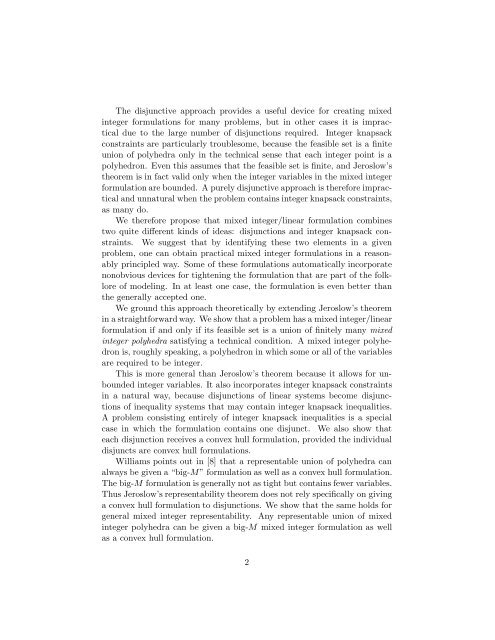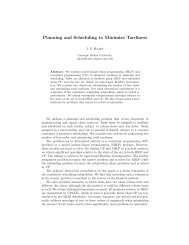A Principled Approach to Mixed Integer/Linear Problem Formulation
A Principled Approach to Mixed Integer/Linear Problem Formulation
A Principled Approach to Mixed Integer/Linear Problem Formulation
You also want an ePaper? Increase the reach of your titles
YUMPU automatically turns print PDFs into web optimized ePapers that Google loves.
The disjunctive approach provides a useful device for creating mixedinteger formulations for many problems, but in other cases it is impracticaldue <strong>to</strong> the large number of disjunctions required. <strong>Integer</strong> knapsackconstraints are particularly troublesome, because the feasible set is a finiteunion of polyhedra only in the technical sense that each integer point is apolyhedron. Even this assumes that the feasible set is finite, and Jeroslow’stheorem is in fact valid only when the integer variables in the mixed integerformulation are bounded. A purely disjunctive approach is therefore impracticaland unnatural when the problem contains integer knapsack constraints,as many do.We therefore propose that mixed integer/linear formulation combinestwo quite different kinds of ideas: disjunctions and integer knapsack constraints.We suggest that by identifying these two elements in a givenproblem, one can obtain practical mixed integer formulations in a reasonablyprincipled way. Some of these formulations au<strong>to</strong>matically incorporatenonobvious devices for tightening the formulation that are part of the folkloreof modeling. In at least one case, the formulation is even better thanthe generally accepted one.We ground this approach theoretically by extending Jeroslow’s theoremin a straightforward way. We show that a problem has a mixed integer/linearformulation if and only if its feasible set is a union of finitely many mixedinteger polyhedra satisfying a technical condition. A mixed integer polyhedronis, roughly speaking, a polyhedron in which some or all of the variablesare required <strong>to</strong> be integer.This is more general than Jeroslow’s theorem because it allows for unboundedinteger variables. It also incorporates integer knapsack constraintsin a natural way, because disjunctions of linear systems become disjunctionsof inequality systems that may contain integer knapsack inequalities.A problem consisting entirely of integer knapsack inequalities is a specialcase in which the formulation contains one disjunct. We also show thateach disjunction receives a convex hull formulation, provided the individualdisjuncts are convex hull formulations.Williams points out in [8] that a representable union of polyhedra canalways be given a “big-M” formulation as well as a convex hull formulation.The big-M formulation is generally not as tight but contains fewer variables.Thus Jeroslow’s representability theorem does not rely specifically on givinga convex hull formulation <strong>to</strong> disjunctions. We show that the same holds forgeneral mixed integer representability. Any representable union of mixedinteger polyhedra can be given a big-M mixed integer formulation as wellas a convex hull formulation.2




